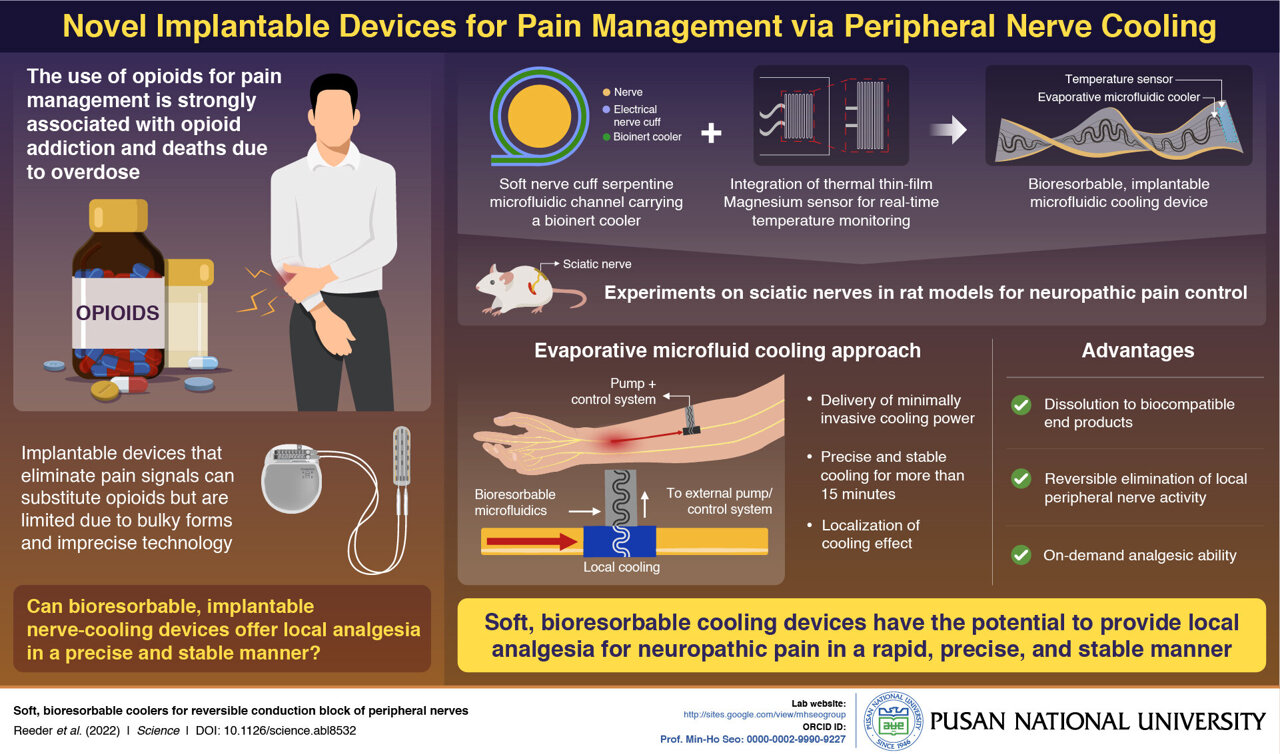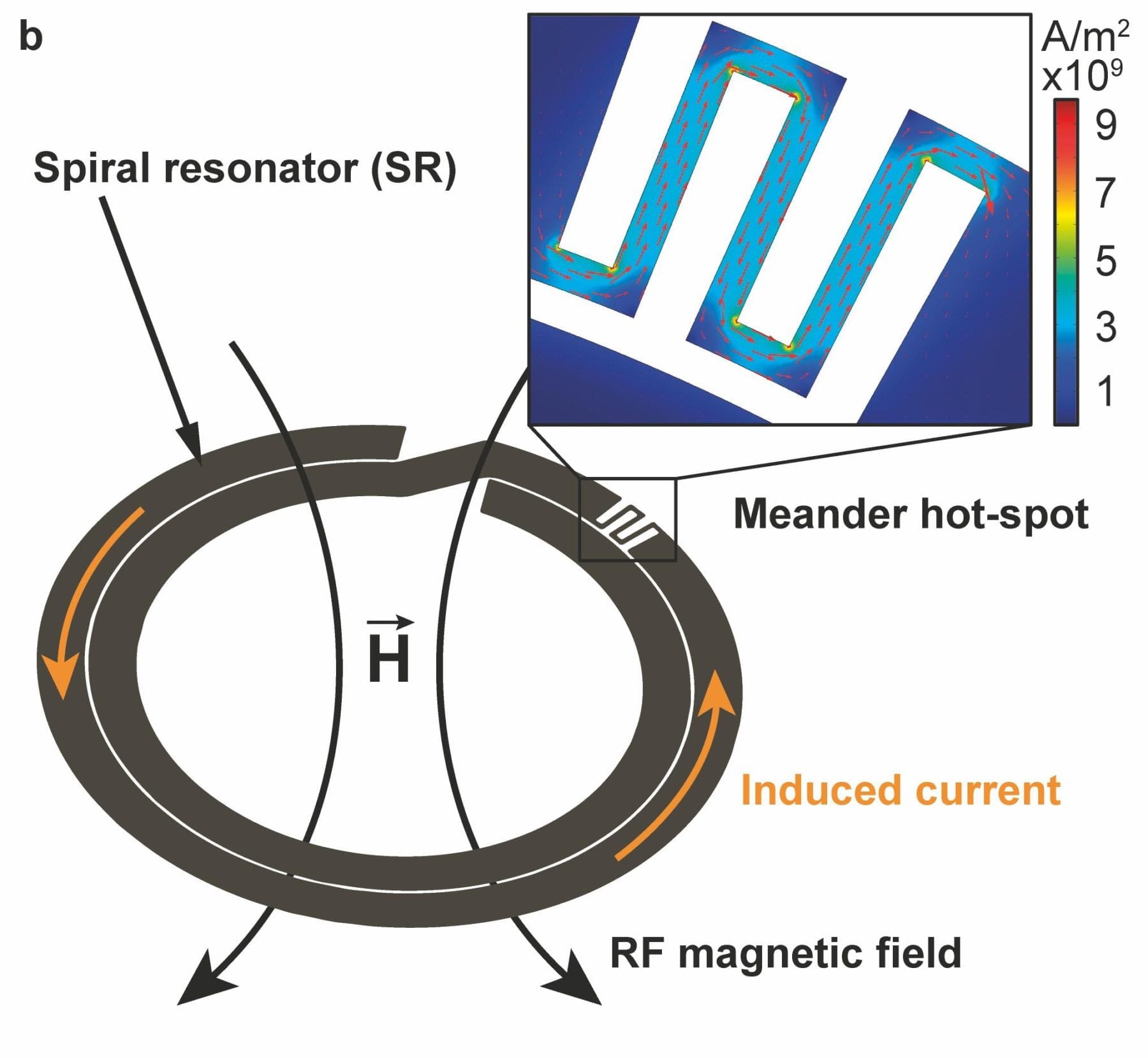
A soft, bioresorbable, implantable device developed by researchers from Pusan National University provides a focused, reversible, and precise cooling effect to block pain signals from peripheral nerves
Image Credit: Pusan National University
Owing to their high efficacy, opioids are used widely for the management of neuropathic pain, despite the increasing rates of opioid addiction and deaths due to overdose. To avoid these side effects, there is an urgent need for pain management approaches that can substitute opioid use.
It is well known that cold temperatures numb the sensation in our nerves. Evidence suggests that cooling peripheral nerves can in fact reduce the velocity and amplitude of neural signals that cause pain, leading to pain relief. What’s great about this approach is that if made possible, it will be completely reversible and non-addictive.
To this end, a team of researchers led by Professor Min-Ho Seo from Pusan National University developed a soft, bioresorbable, implantable device with the potential to cool peripheral nerves in a minimally invasive, focused manner. “Scientists already knew that low temperatures could numb the nerves in the body. But demonstrating this phenomenon with a small device at a clinical level was not an easy task,” said Prof. Seo while discussing the study, which was published in Volume 377 Issue 6601 of Science on June 30, 2022.
To develop the device, the team designed a microfluidics system formed with a bioresorbable material—poly(octanediol citrate)—with interconnects carrying a liquid coolant to a serpentine chamber. To top it off, a Magnesium temperature sensor for real-time temperature monitoring was incorporated at its distal end. The intensity and localization of the cooling effect was regulated by perfluoro pentane (PFP) and dry nitrogen gas (N2)—the two components of the liquid coolant, as well as the geometry of the serpentine chamber.
Next, the team tested the device by implanting it into the sciatic nerves of living rat models with neuropathic pain associated with spared nerve injury. After a three-week evaluation, the team found that the device successfully delivered cooling power to the peripheral nerves of the rats, which led to a reduction in their pain. Fortunately, the delivery of the cooling power occurred in a minimally invasive, stable, and precise manner. What’s more, this application was localized and reversible, and remained effective for almost 15 minutes during one session.
On being submerged in phosphate-buffered saline solution at 75°C, the device, which was made of bioresorbable materials, dissolved within 20 days and got eliminated in approximately 50 days. These findings imply that it has the potential to naturally degrade and get resorbed in the human body.
So, what are the future applications of this device? “The developed device can be used to treat pain after surgery. Since it is connected to an external source of fluid and power like a commercial intravenous (IV) device, it can easily be controlled by the patient. This way, our implantable device will be able to provide targeted and individualized relief without the drawbacks of the addictive pain medications,” said Prof. Seo in response.
With such progress underway, patients with neuropathic pain will finally be able to receive safe and sustainable treatment, without the risk of adverse effects associated with opioid use!
Original Article: Researchers test the efficacy of a soft, bioresorbable, implantable device to block pain signals from sciatic nerves of rat models
More from: Pusan National University
The Latest Updates from Bing News
Go deeper with Bing News on:
Neuropathic pain management
- Pathophysiological Mechanisms of Neuropathic Pain
Successful neuropathic pain management requires the definition of precise sensory profiles. The diagnostic process should aim at finding specific sensory profiles through clinical examination ...
- Treating neuropathic pain and nicotine dependence: Epibatidine derivatives as potential therapeutics
How to treat both neuropathic pain and nicotine dependence using novel epibatidine derivatives as potential therapeutics ...
- Diabetic Neuropathic Pain: Which Treatments Work?
At this stage, off-label injections are performed in pain management centers. Pharmacologic treatments can be combined with techniques such as noninvasive neurostimulation, including transcutaneous ...
- Postamputation and Chronic Neuropathic Pain After Combat Trauma
—This systematic review of studies of combat injury was conducted to establish the prevalence of chronic neuropathic and postamputation pain following combat trauma. The prevalence of residual ...
- What are the Best Nerve Supplements For Neuropathy?
Its systematic approach to nerve pain management sets Nerve Control 911 apart in a saturated market. Leveraging all-natural ingredients to target specific biochemical pathways offers a holistic ...
Go deeper with Bing News on:
Cooling peripheral nerves
- Best Cooling Mattress of 2024
If you’re struggling to stay cool at night, you might need a cooling mattress. These are the best cooling mattresses available, tested and ranked by our sleep experts. McKenzie, a Certified ...
- Best Cooling Mattress Toppers of 2024
Anyone who has experienced this regularly may want to consider getting one of the best cooling mattress toppers, especially if you already like the way your mattress feels. In the mattress ...
- Freeze casting - a guide to creating hierarchically structured materials
The chitosan scaffold was freeze casted with a cooling rate of 10 ° C/min ... the cell wall serve as a structure for repairing peripheral nerves, attracting axons or enabling other biomedical ...
- Best Laptop Cooling Pads 2024: These Coolers Actually Work
Cooling pads typically combine fans with ventilation slots or a mesh surface, optimizing airflow to keep your laptop at peak performance. This not only helps your laptop run smoother but can also ...
- Best Laptop Cooling Pads in 2024
Whether it is a cooling pad to cool the laptop or to help rest it comfortably on a lap for long periods, here is a helpful guide Does your new laptop act a bit more sluggish or make more noise ...










